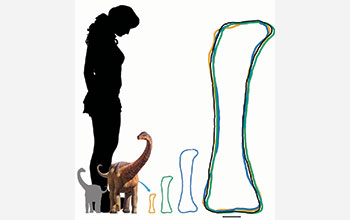Multimedia Gallery
Newly discovered baby Titanosaur (Image 3)
Rapetosaurus at hatching (gray) and a neonate (color) with its femur scaled to that of an adult. The baby titanosaurian sauropod was found buried in the Upper Cretaceous Maevarano Formation of Madagascar.
More about this image
Research funded by the National Science Foundation (NSF) and led by Kristi Curry Rogers of Macalester College in St. Paul, Minnesota, sheds the first light on the life of a young Rapetosaurus, a titanosaurian sauropod buried in the Upper Cretaceous Maevarano Formation of Madagascar.
The researchers employed several lines of evidence to investigate growth strategies in the smallest-known, post-hatching sauropod dinosaur, including developing tests that could be applied to other perinatal dinosaurs.
"This baby’s limbs at birth were built for its later adult mass; as an infant, however, it weighed just a fraction of its future size," said Curry Rogers. "This is our first opportunity to explore the life of a sauropod just after hatching, at the earliest stage of its life."
Curry Rogers and a team that included researchers Megan Whitney of the University of Washington, Mike D’Emic of Adelphi University and Brian Bagley of the University of Minnesota studied thin sections of the tibia and used a high-powered computerized tomography scanner to get a closer look at the microstructures preserved inside the limb bones. The detailed microscopic features of the Rapetosaurus bones revealed patterns similar to those of living animals and made it possible for the scientists to reconstruct the beginning of the dinosaur's post-hatching life.
"We looked at the preserved patterns of blood supply, growth cartilages at the ends of limb bones, and at bone remodeling," said Curry Rogers. "These features indicate that Rapetosaurus grew as rapidly as a newborn mammal and was only a few weeks old when it died." The tiny titanosaur was mobile at hatching and less reliant on parental care than other animals.
The team also observed microscopic zones deep within the bones. They proved similar to the hatching lines in today's reptiles and to neonatal growth lines in extant mammals. The zones indicate the time of hatching in Rapetosaurus, and allowed the scientists to estimate the weight of the newly hatched Rapetosaurus--around 7.7 pounds.
As to what caused the baby's demise, clues came from its cartilage growth plates, which bear a striking resemblance to the modified growth cartilages that occur during starvation among living vertebrates. When taken in the context of the intensely drought-stressed ecosystem represented in the Maevarano Formation, it's clear that this Rapetosaurus had it rough, Curry Rogers said.
"Between its hatching and death just a few weeks later," she said, "this baby Rapetosaurus fended for itself in a harsh and unforgiving environment."
[The specimen was recovered during NSF-supported projects in Madagascar and was prepared with NSF support at Stony Brook University. It relates to Curry Rogers' Faculty Early Career Development (CAREER) award (grant EAR 09-55716) because it is included in the "whole specimen" histological analysis and faunal survey of Malagasy vertebrates proposed in that grant, and supplies microstructural evidence of drought that is indicated by other taphonomic and geological data. The research was primarily funded by grants EAR 09-55716 and EAR 15-28273, but also past grants (D Krause, PI) EAR 94-18816, EAR 97-06302, EAR 10-6477, EAR 11-6517, EAR 04-46488 and EAR 11-23642.]
To learn more, see the NSF press release Newly discovered baby Titanosaur sheds light on dinosaurs' early lives. (Date image taken: 2015-2016; date originally posted to NSF Multimedia Gallery: Nov. 14, 2016) [Image 3 of 7 related images. See Image 4.]
Credit: Kristi Curry Rogers, Macalester College
Images and other media in the National Science Foundation Multimedia Gallery are available for use in print and electronic material by NSF employees, members of the media, university staff, teachers and the general public. All media in the gallery are intended for personal, educational and nonprofit/non-commercial use only.
Images credited to the National Science Foundation, a federal agency, are in the public domain. The images were created by employees of the United States Government as part of their official duties or prepared by contractors as "works for hire" for NSF. You may freely use NSF-credited images and, at your discretion, credit NSF with a "Courtesy: National Science Foundation" notation.
Additional information about general usage can be found in Conditions.
Also Available:
Download the high-resolution JPG version of the image. (876.2 KB)
Use your mouse to right-click (Mac users may need to Ctrl-click) the link above and choose the option that will save the file or target to your computer.



